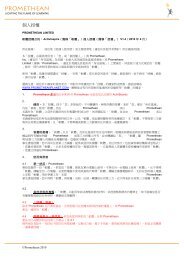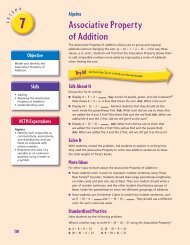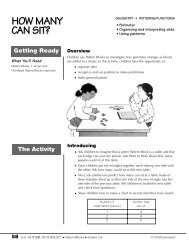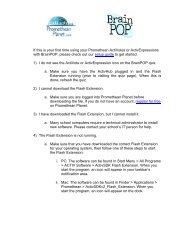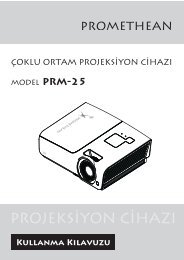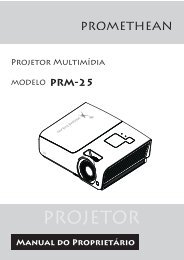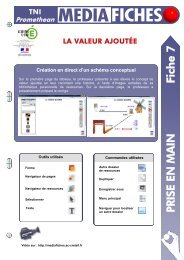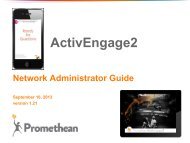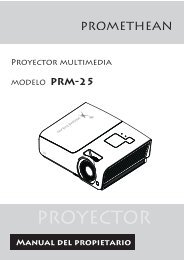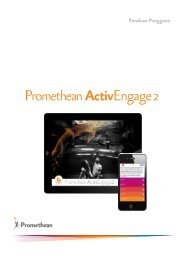Billy Goats Gruff Curriculum Guidance - Promethean Planet
Billy Goats Gruff Curriculum Guidance - Promethean Planet
Billy Goats Gruff Curriculum Guidance - Promethean Planet
You also want an ePaper? Increase the reach of your titles
YUMPU automatically turns print PDFs into web optimized ePapers that Google loves.
The Biilllly <strong>Goats</strong> <strong>Gruff</strong> iinteractiive CD--ROMLinks to curriculum guidanceThe table below shows suggested learning opportunities for each section of the CD-ROM, withreference to the following documents:•• the renewed Primary Framework for literacy and mathematics (DfES, 2006): literacy and mathsstrands are referenced as L1, L2, etc. and M1, M2 etc.•• <strong>Curriculum</strong> <strong>Guidance</strong> for the Foundation Stage (DfES, 2000): e.g. CD2 (Music) y1•• learning objectives from the National <strong>Curriculum</strong> programmes of study for music, ICT, science,and design and technology: e.g. KS1 Mu 1a.This information will be updated in line with changes to the national frameworks. Visitwww.yellow-door.net for further information.The storyLearningopportunitiesFoundation Stage Year 1 Year 2Listen, join inand respondL2, 8 Listen with enjoymentto stories, songs, rhymesand poems, sustain attentivelistening and respond withrelevant comments,questions or actionsL2 Respond to presentationsby describing characters,repeating some highlightsand commentingconstructivelyIdentify anddiscuss storyelementsL1, 3 Use talk to organise,sequence and clarifythinking, ideas, feelings andeventsL7, 8 Show anunderstanding of theelements of stories, such asmain character, sequence ofevents and openingsL1 Retell stories, orderingevents using story languageL7 Identify the main eventsand characters in storiesL8 Explain their reactions totexts, commenting onimportant aspectsIdentify wordfeaturesL1, 2, 7 Extend theirvocabulary, exploring themeanings and sounds of newwordsL2 Listen with sustainedconcentration, building newstores of words in differentcontextsL7 Explore the effect ofpatterns of language andrepeated words and phrasesL7 Explore how particularwords are used, includingwords and expressions withsimilar meaningsThe songLearningopportunitiesFoundation Stage Year 1 Year 2Sing songs andrhymesRespond withmovementCD2 (Music) y1 Join infavourite songsCD2 (Music) y3 Respond tosound with body movementCD2 (Music) b5 Imitate andcreate movement inresponse to musicPD1 (Movement) y2Respond to rhythm, musicand story by means ofgesture and movementKS1 Mu 1a Use their voices expressively by singing songsand speaking chants and rhymes
Tell it yourself – Play with the storyLearningopportunitiesFoundation Stage Year 1 Year 2Play, withimagination, toact out or reenactstoriesL1, 3 Use talk to organise,sequence and clarifythinking, ideas, feelings andeventsL1, 4, 8 Use language toimagine and recreate rolesand experiencesL4 Explore familiar themesand characters throughimprovisation and role playL4 Act out their own andwell-known stories, usingvoices for charactersL4 Adopt appropriate roles insmall or large groups andconsider alternative coursesof actionUse elements ofstories asmodels for ownwritingL1 Enjoy listening to andusing spoken and writtenlanguage and readily turn toit in play and learningL1 Retell stories, orderingevents using story languageL9 Use key features ofnarrative in their own writingL1 Tell real and imaginedstories using the conventionsof familiar story languageTell it yourself – What happened next?LearningopportunitiesFoundation Stage Year 1 Year 2Retell narrativesin the correctsequenceTalk about orderusing words likefirst, next, etc.L7 Retell narratives in thecorrect sequence, drawingon the language patterns ofstoriesM2 Use ordinal numbers indifferent contextsL1 Retell stories, orderingevents using story languageL7 Recognise the mainelements that shape differenttextsGames and activities – Who can you hear?LearningopportunitiesFoundation Stage Year 1 Year 2Explore differentsounds ofinstrumentsCD2 (Music) y2 Show aninterest in the way musicalinstruments soundCD2 (Music) g2 Explore thedifferent sounds ofinstrumentsKS1 Mu 1b Play tuned and untuned instrumentsGames and activities – Find the rhymeLearningopportunitiesFoundation Stage Year 1 Year 2Listen to a rangeof rhymes andrecognise therepeatedpatternsL5 Explore and experimentwith sounds, words and textsL5 Link sounds to lettersL5 Recognise and usealternative ways of spellingphonemes
Find out more about …LearningopportunitiesFoundation Stage Year 1 Year 2ICTKUW4 (ICT) ELG1 Use ICTto support their learningKS1 ICT 1a Gather information from CD-ROMSLiteracyL7 Show an understandingof how information can befound in non- fiction texts toanswer questions aboutwhere, who, why and howL8 Distinguish fiction andnon-fiction texts and thedifferent purposes forreading themL7 Draw together ideas andinformation from across awhole text, using simplesignposts in the textScienceDesign andtechnologyKUW1 (E&I) ELG1Investigate objects andmaterialsKUW1 (E&I) ELG2 Find outabout, and identify, somefeatures of living thingsKUW6 (Place) ELG1Observe, find out about andidentify features in the placethey live and the naturalworldKUW3 (D&M) y1 Investigateconstruction materialsKUW3 (D&M) b1 Joinconstruction pieces togetherto build and balanceKUW3 (D&M) g1 Constructwith a purpose in mind, usinga variety of resourcesKUW3 (D&M) ELG1 Buildand construct with a widerange of objects, selectingappropriate resources, andadapting their work wherenecessaryKS1 Sc2 2a Recognise and compare the main external partsof the bodies of humans and other animalsKS1 Sc2 2b Understand that humans and other animalsneed food and water to stay aliveKS1 Sc2 2f Understand that animals can produce offspringand that these offspring grow into adultsKS1 Sc2 5b Identify similarities and differences betweenlocal environments and ways in which these affect animalsand plants that are found thereKS1 Sc3 1d Find out about the uses of a variety of materials(for example, glass, wood) and how these are chosen forspecific uses on the basis of their simple propertiesKS1 D&T 1b Develop ideas by shaping materials and puttingtogether componentsKS1 D&T 1e Communicate their ideas using a variety ofmethods, including drawing and making modelsTeacher resourcesLearningopportunitiesFoundation Stage Year 1 Year 2Use and extendvocabularyL1, 2, 7 Extend theirvocabulary, exploring themeanings and sounds of newwordsL9 Find and use new andinteresting words andphrases, including storylanguageL9 Make adventurous wordand language choicesappropriate to the style andpurpose of the textWrite aboutsettings andcharactersL11 Write labels andcaptions and begin to formsimple sentences sometimesusing punctuationL9 Create short simple textson paper and on screen thatcombine words with imagesL9 Independently choosewhat to write about, plan andfollow it throughL7 Give some reasons whythings happen or characterschangeRetell and createstoriesL7 Retell narratives in thecorrect sequence, drawingon the language patterns ofstoriesL10 Attempt writing forvarious purposes, usingfeatures of different formssuch as lists and storiesL1 Retell stories, orderingevents using story languageL7 Recognise the mainelements that shape differenttextsL9 Use key features ofnarrative in their own writingL10 Write chronological textsusing simple structuresL1 Tell real and imaginedstories using the conventionsof familiar story languageL9 Draw on knowledge andexperience of texts indeciding and planning whatand how to writeL10 Use planning toestablish clear sections forwriting



